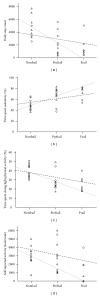Physical Activity across Frailty Phenotypes in Females with Parkinson's Disease
- PMID: 22919489
- PMCID: PMC3420090
- DOI: 10.1155/2012/468156
Physical Activity across Frailty Phenotypes in Females with Parkinson's Disease
Abstract
Females with Parkinson's disease (PD) are vulnerable to frailty. PD eventually leads to decreased physical activity, an indicator of frailty. We speculate PD results in frailty through reduced physical activity. Objective. Determine the contribution of physical activity on frailty in PD (n = 15, 65 ± 9 years) and non-PD (n = 15, 73 ± 14 years) females. Methods. Frailty phenotype (nonfrail/prefrail/frail) was categorized and 8 hours of physical activity was measured using accelerometer, global positioning system, and self-report. Two-way ANCOVA (age as covariate) was used to compare physical activity between disease and frailty phenotypes. Spearman correlation assessed relationships, and linear regression determined associations with frailty. Results. Nonfrail recorded more physical activity (intensity, counts, self-report) compared with frail. Self-reported physical activity was greater in PD than non-PD. In non-PD, step counts, light physical activity time, sedentary time, and self-reported physical activity were related to frailty (R = 0.91). In PD, only carbidopa-levodopa dose was related to frailty (r = 0.61). Conclusion. Physical activity influences frailty in females without PD. In PD females, disease management may be a better indicator of frailty than physical activity. Further investigation into how PD associated factors contribute to frailty is warranted.
Figures


References
-
- Bergman H, Béland F, Karunananthan S, Hummel S, Hogan D, Wolfson C. Development of a framework for understanding and studying frailty. Gerontologie et Societe. 2004;109(2):15–29.
-
- Borges LL, Menezes RL. Definitions and markers of frailty: a systematic review of literature. Reviews in Clinical Gerontology. 2011;21(1):67–77.
-
- Levers MJ, Estabrooks CA, Ross Kerr JC. Factors contributing to frailty: literature review. Journal of Advanced Nursing. 2006;56(3):282–291. - PubMed
-
- Fried LP, Tangen CM, Walston J, et al. Frailty in older adults: evidence for a phenotype. Journals of Gerontology. 2001;56(3):M146–M156. - PubMed
LinkOut - more resources
Full Text Sources

